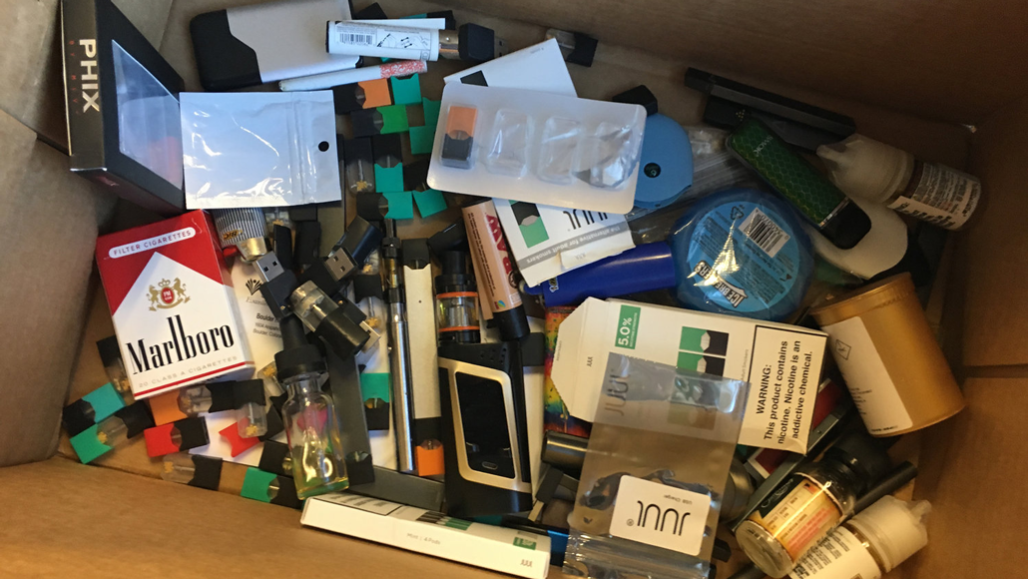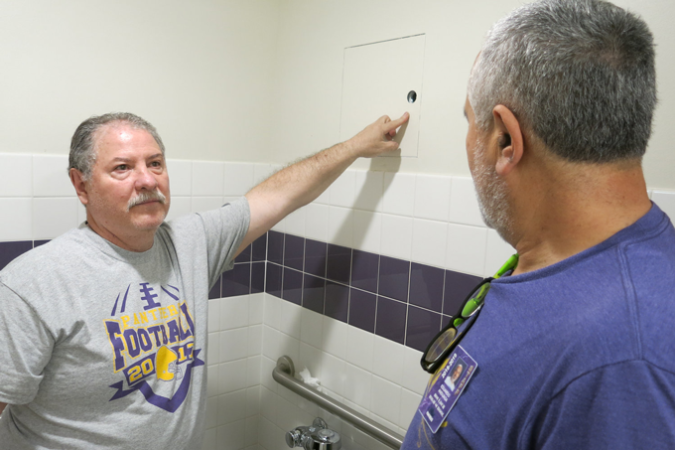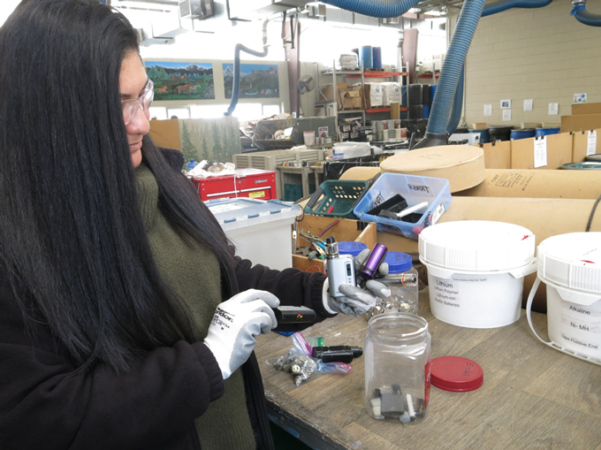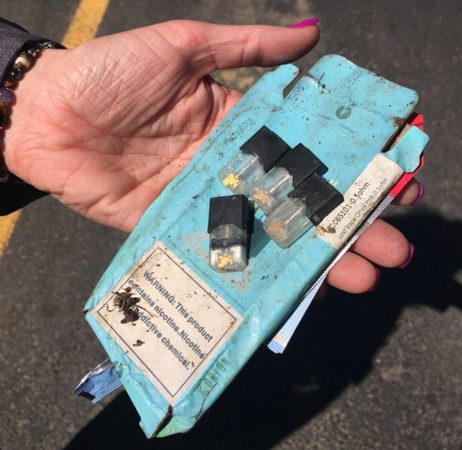Don’t toss that vape!
E-cigarette wastes are becoming toxic headaches for schools and cities

Here’s a box of vaping products collected at Boulder High School. The school's assistant principal stores this trash for later delivery to the county's hazardous-waste facility.
John Daley/Colorado Public Radio
Share this:
- Share via email (Opens in new window) Email
- Click to share on Facebook (Opens in new window) Facebook
- Click to share on X (Opens in new window) X
- Click to share on Pinterest (Opens in new window) Pinterest
- Click to share on Reddit (Opens in new window) Reddit
- Share to Google Classroom (Opens in new window) Google Classroom
- Click to print (Opens in new window) Print
Kristen Lewis is the assistant principal at Boulder High School in Colorado. A large cardboard box sits in her office. It’s where she tosses the spoils of her ongoing battle with the newest student addiction: vaping. “This is what I call the Box of Death,” she explains. Inside it “is everything that we’ve confiscated.”
There are vape pens, such as JUULs (the leading brand of e-cigarettes). You also can see dozens of disposable pods that once were full of flavored, nicotine-rich liquids. There is even a lonely box of Marlboros.
Students aren’t allowed to smoke or vape on school grounds. But Lewis and other school employees still regularly pluck e-cigs from students’ hands or find vape-related trash littering the halls and restrooms.
In the school parking lot, Lewis spots discarded packaging. “This one,” she says, is from “an Orion vape device, it looks like.” A little further on, she spots a pile of JUUL pods. More vaping trash shows up in the yards of homes across from the school and along the edge of nearby Boulder Creek.
This trash reveals “how much [vaping] has become a part of our students’ lives,” Lewis says. “And that’s what’s scary… It really has become an epidemic.” She notes, “every high school in the nation is really dealing with this.”
Colorado recently topped the national list for teen vaping. That’s based on data reported in June 2018 by the U.S. Centers for Disease Control and Prevention. Boulder, it turns out, is a Colorado hot spot. The surge in vaping here, as elsewhere, has led to health problems. Less obvious, this new teen obsession is creating a new environmental problem. Discarded vape pens and pods now litter city streets and schools across the nation.
And they’re not just unsightly. They also can be toxic. Indeed, cities are beginning to argue that this trash is really hazardous waste.
Vaping waste removal strategies
The disposable pod is a small plastic cartridge holding a flavored, nicotine-rich liquid. It snaps onto a base, often called a “vape pen.” This may can look like an actual pen or even a small thumb drive. In 2017, people bought more than 16 million of the devices in the United States. That’s according to a report by the Truth Initiative. It’s a nonprofit group dedicated to ending tobacco use. And its 2017 figure — now long out of date — doesn’t include the disposable e-liquid pods. For JUUL, those pods often are sold in packs of four.

At Boulder High, custodian Allen Chavez points to where he often finds empty e-cig pods. Some have been stuffed between furniture cushions. In a boy’s bathroom, he points to a small hole in the wall. That’s where he’s seen students stick empty pods.
“I’ve caught a couple of guys [putting them there],” says Chavez. But most time students simply tell him, ‘It wasn’t me!'”
Angel Ocon played football at Boulder High. He’s seen plenty of discarded e-cig pods under the school bleachers. “If you use vapor or juul or something, all you’re going to think about is, like, getting the buzz,” Ocon says. He explains that users are not worried about “where you’re going to throw away your stuff.”
Shelly Fuller manages the local county’s hazardous-waste program. No e-cig device or its parts should ever be tossed in the trash, she says. Instead, vapers should collect them for disposal at a hazardous-waste or recycling center.
At a battery-sorting table, Fuller shows off a bucket of vape trash. This new part of the waste stream only emerged about two years ago, she says. Now people regularly drop off vaporizers, pods and batteries. Such items also show up in household trash.

Different parts of an e-cig must be managed separately, she explains. These devices have batteries, usually the lithium-ion type. Fuller ships them to a recycling facility in Arizona. She sends e-liquid pods instead to a facility in eastern Colorado. Those pods hold traces of concentrated nicotine. It’s an acutely hazardous waste, she says. Even small doses can be lethal to people or small animals. And the nicotine needn’t be eaten or inhaled. It can pass right through the skin. That’s why “we’re shipping it off with our poisons or toxics,” she says. It needs to be recycled or incinerated.
Risks of poisoning or contamination
A recent study of a dozen high schools in the San Francisco Bay Area in California found trash from vaping, smoking and cannabis products in and near area high schools.
At higher-income high schools, the researchers reported finding “substantial quantities of JUUL and JUUL-compatible e-cigarette waste.” Most came from pods with flavored liquids “other than tobacco flavor.” At lower-income schools, the researchers found a different mix of wastes, including remnants of small flavored cigars. At all the high schools, large quantities of butts turned up from menthol-flavored cigarettes.
Brittany Carpenter is a Boulder County tobacco-education specialist. One e-cig pod can start out with as much or more nicotine than a pack of cigarettes, she notes. And there’s more to be concerned about in an e-liquid than its nicotine. Some types contain heavy metals, Carpenter notes, “including lead, tin and nickel.”

All of these things can end up in the ground or water if they’re not disposed of properly, says John Volckens. He’s an environmental health researcher at Colorado State University in Fort Collins. “As the battery degrades, the compounds in the battery can leach into water nearby,” he says. Wastes from a discarded e-cig or pod, then, doesn’t really go away, he says. It just goes somewhere else.
And to date, the vaping industry has done little to push for a recycling of its products, he adds.
In fact, some vaping advocates claim these pollution concerns are overblown.
“Compared to all of the household products that we throw out in the garbage every day,” says Gregory Conley, “there is no environmental damage [from vaping wastes]. Conley is president of the American Vaping Association. It’s based in Stamford, Conn. He says, “Most pods, by the time someone wants to recklessly throw them on the ground, they’ve been vaped.” As a result, he claims, “there’s little to no liquid left in that pod.” And in the end, he argues, it’s really up to vapers to pick up their wastes.
JUUL, the market leader, declined interview requests. The company website states that its pods are not meant to be refilled and can be thrown away. That is contrary to what Boulder County advises. The county website recommends that a JUUL’s battery-powered base should be disposed of in the same manner as other electronics, such as cell phones.
Stephanie Faren directs health services for the Boulder Valley School District. She says, “This is a whole new thing that, really.” People talk about vape risks. But the pollution, she says, that’s something “I don’t think many people have even given any thought to.”






